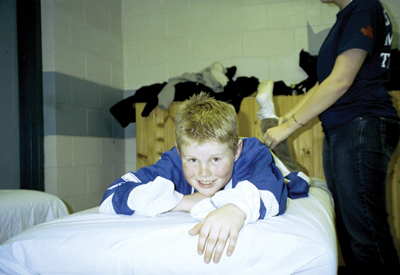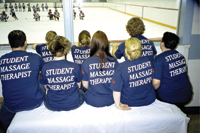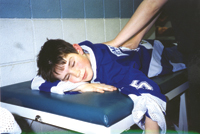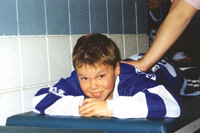
Features
Practice
Technique
Sport Medicine & the Adolescent Athlete
Mont Tremblant was the idyllic setting for the 2002 Canadian Athletic Therapists Association Conference. The topic, The Adolescent Athlete, gleaned an abundance of information. CATA conference topics are often suitable for Massage Therapists who work in a sport medicine environment and attendance should be a consideration.
September 24, 2009 By Jonathon Maister
Mont Tremblant was the idyllic setting for the 2002 Canadian Athletic Therapists Association Conference. The topic, The Adolescent Athlete, gleaned an abundance of information. CATA conference topics are often suitable for Massage Therapists who work in a sport medicine environment and attendance should be a consideration.
This article is a summary of pertinent information and focuses on the nature of injuries among adolescents, for they are not merely miniature adults. Their injuries and predispositions to injury are unique. It is a time of psychological and physiological transition with profound ramifications for the health care professionals who work with them.
 Consider: Anatomically speaking they have lax ligaments and bones with open epiphyses. Their physical size is not yet matched by their strength. They are likely to be hypermobile but don’t have the strength to work effectively in the outer ranges of movement.
Consider: Anatomically speaking they have lax ligaments and bones with open epiphyses. Their physical size is not yet matched by their strength. They are likely to be hypermobile but don’t have the strength to work effectively in the outer ranges of movement.
Likewise strains and sprains can easily result in avulsion fractures – tendons and ligaments might be considered soft tissues, but their tensile strength exceeds the resilience of the immature bones. Injury severity may be amplified if epiphysial growth plates are directly affected.
 Psychologically these immature athletes have little experience with injury. Unrealistic perceptions of pain and injury severity are possible and a sensible approach to rehabilitation may
Psychologically these immature athletes have little experience with injury. Unrealistic perceptions of pain and injury severity are possible and a sensible approach to rehabilitation may
be more difficult to implement.
To expand on these points. Adolescents have multiple open growth plates, all of which are susceptible to injury.
These may be apophyses, which are attachment points of ligaments and tendons. Hence injuries to these structures such as Osgood – Schlatter’s Disease (Tibia Tubercle), Sinding Larsen Johannson’s Disease (Inferior Pole of the Patella), Sever’s Disease (Posterior calcaneus), Hip Apophysitis (AIIS, ASIS,
Iliac crest attachments).
 For this reason sprains and strains which appear unduly severe and or do not respond to orthodox treatment should be X-rayed and referred. Likewise adolescents are susceptible to Osteochondroses (Degenerative changes in the bone’s ossification centres). Examples of these are Perthe’s Disease (Slipped Capital Femoral epiphysis of the femoral neck), Kohlers Disease (Navicular), Kienbock’s Disease (Lunate).
For this reason sprains and strains which appear unduly severe and or do not respond to orthodox treatment should be X-rayed and referred. Likewise adolescents are susceptible to Osteochondroses (Degenerative changes in the bone’s ossification centres). Examples of these are Perthe’s Disease (Slipped Capital Femoral epiphysis of the femoral neck), Kohlers Disease (Navicular), Kienbock’s Disease (Lunate).
Vague symptoms in these anatomical regions especially in the absence of a definite mechanism are a concern that should be referred to an MD. Bones of adolescents are less resilient than adults and organs tend to absorb more of the direct trauma. Internal derangement of viscera is more likely and should be a consideration in contact sports.
 To be borne in mind is the pervasive growth spurt that adolescents undergo. With it comes a change in self-perception as well as a decrease in kinaesthetic perception. Hence co-ordination is compromised and injury is more likely. With time adulthood is reached and the danger abates, but Sport Massage Therapists should be particularly aware during the “danger period.”
To be borne in mind is the pervasive growth spurt that adolescents undergo. With it comes a change in self-perception as well as a decrease in kinaesthetic perception. Hence co-ordination is compromised and injury is more likely. With time adulthood is reached and the danger abates, but Sport Massage Therapists should be particularly aware during the “danger period.”
Massage Therapists should be mindful of these when dealing with young athletics. The time we spend one-on-one with athletes likely exceeds that of other health care professionals, we are more likely to detect nuances of change in their psychological well-being.
We are privy to observations and knowledge that impact directly on the well-being of our young sporting community. This we must use to further our mandate to assist athletes wherever possible in our scope of practice.
Acknowledgement:
Boulay, John. Bsc. EMT CAT (C) DO “Physiological Response of Adolescents to Trauma” CATA Conference May 2002
Jonathan Maister, BsocSci (UCT) CAT(C) RMT, is a regular contributor to this publication. He teaches part-time at ICT Kikkawa College and is in private practice in Markham, Ontario
Print this page